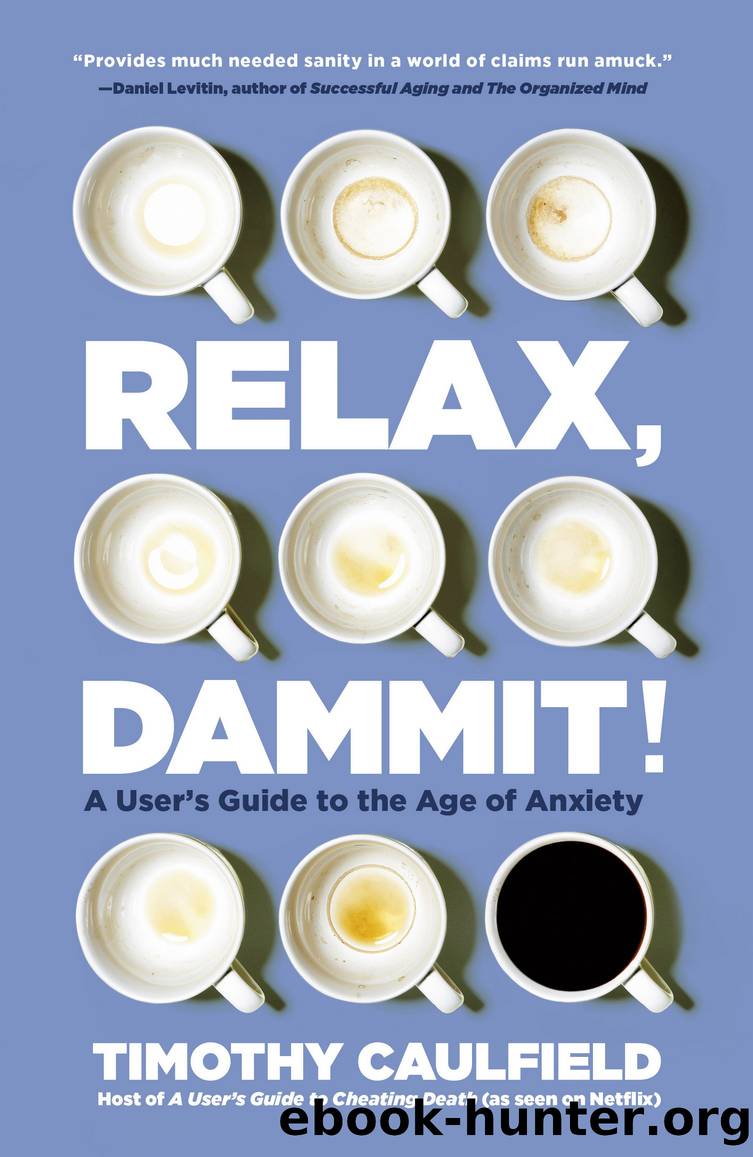Relax, Dammit! by Timothy Caulfield

Author:Timothy Caulfield [Caulfield, Timothy]
Language: eng
Format: epub
Publisher: Penguin Canada
Published: 2020-12-02T00:00:00+00:00
III
EVENING
5:00 PMâExercise
This. Do this.
Do whatever you enjoy. Flipping tractor tires, walking with friends, spinning in the dark to loud music, skipping rope, running stairs, jazzercise, parkour, Ultimate Frisbee, wall climbing, CrossFit (but I donât need to hear about it), cycling, wrestlingâ¦Just. Do. Something!
Yes, evidence tells us that particular exercises (such as high-intensity intervals and resistance training) provide more physiological benefits in a more efficient manner than other activities. And some exercise fads seem to be mostly science-free distractions taking up the space of real exercise (Iâm thinking of you, hot yoga). But we get the greatest benefit from just being active. So be active. The benefits are so well known and so well established that there is very little to add here. Almost always, exercise is the right decision.
But is after work the best time to exercise? Fitness pundits have much to say about optimizing the timing of workouts, but in reality, the evidence is all over the map on this issue. Some studies suggest that working out in the morning may help with weight loss. There is evidence that afternoon workouts might be best for controlling blood glucose. And evening workouts, at least according to a 2019 study involving mice on a treadmill, are the most productive and result in the best performance. Yet much of this research is less than compelling. Often the data comes from small studies or short-term experiments that find only small differences. And some of the evidence comes from animal studies. This should always lead to a cautious interpretation of the data. Exercise isnât a rat race.
Approximately 80 percent of the U.S. population doesnât get the recommended amount of exercise (which is a modest 150 minutes of moderate aerobic exercise per week, plus muscle-strengthening activities). In Canada, the numbers are similarly discouraging. And for children, the numbers are even worse, with only 7 percent getting the recommended amount of moderate to vigorous exercise. And we move much less than we think we do. A 2018 study from Canada found that people report that they are physically active about 50 minutes a day but, when objectively measured, it turns out they are active for only 23 minutes. (This is a good reminder to move more than you think you need to move!) Given this grim reality, the overriding priority should be to simply get people physically active any timeâmorning, noon, or night. The best time of day to exercise is when you want to exercise.
I usually exercise quite late in the day, often starting after 8 PM. I find this helps me wind down and creates a boundary between work and sleep. (An accumulating body of evidence has found that, contrary to conventional wisdom, evening workouts are not associated with poor sleep.) Donât let pedantic exercise adviceâabout timing, hydration, breathing, clothing, shoes, supplements, or the number and kinds of repetitions of an activity we should be doingâconfuse the simple central message: just move!
Download
This site does not store any files on its server. We only index and link to content provided by other sites. Please contact the content providers to delete copyright contents if any and email us, we'll remove relevant links or contents immediately.
| Coloring Books for Grown-Ups | Humor |
| Movies | Performing Arts |
| Pop Culture | Puzzles & Games |
| Radio | Sheet Music & Scores |
| Television | Trivia & Fun Facts |
Spell It Out by David Crystal(36021)
Professional Troublemaker by Luvvie Ajayi Jones(29571)
We're Going to Need More Wine by Gabrielle Union(18951)
The Secret History by Donna Tartt(18808)
Cat's cradle by Kurt Vonnegut(15155)
The Goal (Off-Campus #4) by Elle Kennedy(13470)
The Social Justice Warrior Handbook by Lisa De Pasquale(12126)
The Break by Marian Keyes(9289)
Crazy Rich Asians by Kevin Kwan(9147)
The remains of the day by Kazuo Ishiguro(8789)
Thirteen Reasons Why by Jay Asher(8767)
Educated by Tara Westover(7917)
The handmaid's tale by Margaret Atwood(7663)
Giovanni's Room by James Baldwin(7164)
Win Bigly by Scott Adams(7078)
This Is How You Lose Her by Junot Diaz(6761)
The Rosie Project by Graeme Simsion(6157)
Six Wakes by Mur Lafferty(6119)
The Power of Now: A Guide to Spiritual Enlightenment by Eckhart Tolle(5584)
